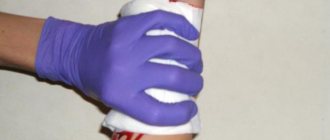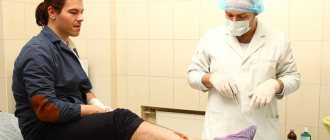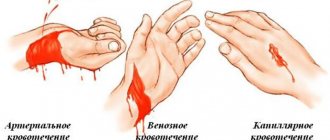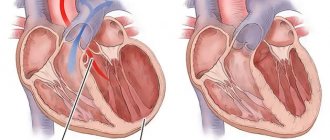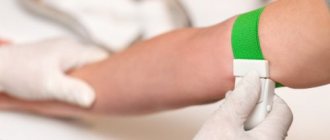When bleeding, the rate of blood loss can be a concern, so in many cases you need to act quickly. First aid measures depend on the type of bleeding, its location, the nature of the injury and some other factors. In this article we will talk about ways to combat blood loss in different situations.
Guidelines and a poster for stopping bleeding on the stand are available after the article.
Causes of bleeding
The following factors can cause bleeding:
- mechanical damage to blood vessels;
- neoplasm or inflammatory process in the walls of blood vessels;
- deterioration of the integrity of blood vessels due to infection, lack of vitamins or poisoning of the body.
Remember that timely assistance with bleeding can save the victim’s life!
1 Help with bleeding. Types of bleeding
2 Help with bleeding. Types of bleeding
3 Help with bleeding. Types of bleeding
Bleeding in the veins of the neck
Why is damage to the veins in the neck dangerous?
- Without professional skills, it is impossible to apply a bandage without causing suffocation in the victim;
- vessels in the neck area are large in diameter, their injuries cause profuse and rapid blood loss, so first aid must be provided as quickly as possible;
- Air can be sucked into the lumen of a large vessel, resulting in the formation of an air plug (embolism), which can cause death.
How to stop bleeding if your neck is injured:
- Lay the person down so as to provide easy access to the wound.
- If possible, apply a cotton or gauze cloth folded several times and soaked in antiseptic (hydrogen peroxide) to the wound.
- Press the area above and below the injury with three fingers (ring, middle and index) of both hands folded together.
You can consider that you have achieved results if the bleeding has stopped or greatly weakened, but the pulsation of deep vessels is felt under your fingers.
Nose bleed
Types of bleeding
The type of bleeding depends on which vessel is damaged, in which part of the body it is localized, and the intensity of blood loss.
Classification according to the type of damage to blood vessels:
- capillary bleeding;
- venous;
- internal (parenchymal);
- arterial;
- mixed bleeding.
Classification according to the cause of bleeding:
- abnormal bleeding;
- traumatic.
Classification according to the location of blood loss:
- external;
- internal.
Classification by volume of blood loss:
On average, about 5 liters of blood circulates in the body of an adult. Depending on the volume of fluid spilled, doctors distinguish the following degrees of blood loss:
- mild degree (less than 0.5 liters);
- medium (less than 1 liter);
- heavy (about 1.5 liters);
- massive (about 2.5 liters);
- lethal (about 3 liters), i.e. more than half of the total blood volume;
- absolutely lethal (more than 3.5 liters), i.e. above 60%.
First aid for bleeding is a system of therapeutic and preventive measures that must be taken in case of damage to blood vessels (arteries, capillaries and veins) until qualified medical assistance becomes available. Each type of bleeding has its own characteristics in providing assistance.
Rules for applying a tourniquet
A tourniquet is applied only to stop arterial bleeding, and also if an arm or leg was amputated as a result of injury. In other cases, the use of a tourniquet is not advisable due to the high degree of injury to the skin and soft tissues. To temporarily stop bleeding, you can use an Esmarch tourniquet or a handy rubber material.
Rules for applying a tourniquet for bleeding
Basic rules and sequence of applying a tourniquet:
- If possible, raise your arm or leg for a few seconds and fix it in a comfortable position - this will lead to the outflow of venous blood.
- The tourniquet is applied over clothing or a piece of fabric is placed under it. This is necessary to protect the skin.
- The first two turns need to be made as tight as possible, they are the ones who stop the blood, while the crosshair is applied on the back side of the artery.
- The maximum duration of applying a tourniquet in the warm season should not exceed 90 minutes, in the cold season - 60 minutes. If during this time the victim cannot be taken to the hospital, the tourniquet should be loosened for 10-15 minutes and the artery should be pressed with a finger. Then the tourniquet is applied again, 1-2 cm above or below the previous location. The duration of applying a tourniquet to children should not exceed an hour.
- The time for applying the tourniquet must be written down and attached in a visible place. In reality, due to problems with drawing up (searching for paper and pens in field or combat conditions, while there are more pressing tasks of saving the life of the victim) and preserving (the paper gets soaked in blood and spreads or is simply lost) notes, in modern In practice, it is customary to write the time of application of the tourniquet with a marker directly on a visible place on the body, for example, it could be the forehead; it is recommended to indicate the name of the rescuer or the person who applied the tourniquet.
Esmarch rubber hemostatic tourniquet
Indications:
- traumatic amputation of a limb;
- inability to stop bleeding with other known means.
Advantages:
- quite fast and the most effective way to stop bleeding from the arteries of the limb.
Flaws:
- the use of a tourniquet leads to complete bleeding of the distal limbs due to compression of not only damaged great vessels, but also collaterals, which for more than 2 hours can lead to gangrene;
- nerve trunks are compressed, which causes post-traumatic plexitis with subsequent pain and orthopedic syndrome;
- cessation of blood circulation in the limb reduces the resistance of tissues to infection and reduces their regenerative abilities;
- the use of a tourniquet can cause severe vasospasm and lead to thrombosis of the operated artery;
- restoration of blood circulation after use of a tourniquet contributes to the development of tourniquet shock and acute renal failure;
- the use of a tourniquet is impossible on the torso or is limited in anatomically difficult areas.
Errors:
- its use without indications, that is, for venous and capillary bleeding;
- application on a naked body;
- far from the wound;
- weak or excessive tightening;
- poor fastening of the ends of the tourniquet;
- lack of accompanying note;
- use more than 2 hours;
- covering the tourniquet with a bandage or clothing.
If there is severe bleeding, a tourniquet is applied to the upper third of the shoulder or middle third of the thigh. In these areas, the anatomical location of the humerus and femur makes it possible to stop the bleeding with maximum efficiency. Applying a tourniquet in other places will not give the desired result. If a limb is torn off, applying a tourniquet is mandatory even in the absence of bleeding.
If the tourniquet is applied correctly, characteristic signs will appear after a while. The limb below the application site will turn pale and cold, the bleeding will stop, and the peripheral pulse will not be palpable. The intersection of the tourniquet should be on the outside of the arm or leg, since the artery is located on the axillary side.
General rules of first aid for bleeding
If the victim has lost a significant amount of blood, try to lay him down and elevate his legs.
Do not touch the wound with your hands or remove glass shards from it.
If sand and rust get into the wound, do not wash the damage, as this will increase the bleeding.
If the wound becomes dirty, you need to carefully remove the dirt in the direction from the wound, then treat the cleaned edges with an antiseptic.
When treating the edges of a wound with an iodine solution, do not allow the antiseptic to get inside the wound.
Depending on the type of blood loss, try to stop the bleeding using a tourniquet, twisting, or squeezing the damaged vessel.
First aid for capillary bleeding
Bleeding from the capillaries is not accompanied by large blood loss and stops relatively quickly. A sign of capillary damage is the appearance of a gentle stream of blood on the wound.
First aid for this bleeding includes treating the edges of the wound with an alcohol antiseptic (iodine), on which an aseptic gauze bandage is applied. Please note that the bandage is not tight. Usually, with capillary bleeding, there is no need to go to the hospital, with the exception of situations where the damage is extensive.
1 First aid for bleeding
2 First aid for bleeding
3 First aid for bleeding
First aid for venous bleeding
A sign of venous bleeding is rapidly flowing dark blood. Its flow is uniform, without gushing or pulsating.
With venous bleeding, blood clots may appear; they cannot be removed, since in this case blood loss may increase.
To stop bleeding, apply a pressure aseptic bandage to the wound. If blood loss continues, it is necessary to apply a tourniquet below the damaged area. To reduce injury to soft tissues and skin, a soft pad is placed on them (under the tourniquet). It is necessary to make a note indicating the time of application of the tourniquet. The maximum time for wearing a tourniquet is 2 hours in warm weather and 1 hour at sub-zero temperatures. The tourniquet cannot be held longer than this time, otherwise the bloodless tissue will begin to die. If you don’t have a tourniquet, you can make twists from available materials: a bandage, a belt, a towel, a piece of fabric using a handle and a short stick. The time frame for the spins is the same. Try not to use any hemostatic drugs without a doctor's prescription.
First aid for arterial bleeding
Arterial bleeding is one of the most dangerous. The main sign of arterial damage is bright scarlet blood flowing out in a pulsating stream at high speed. If large arteries are damaged, the blood begins to flow intermittently, like a fountain.
First aid for this bleeding is to apply a hemostatic tourniquet above the level of the wound. You can also use a twist. Time restrictions are the same.
If there is no tourniquet or twist, you can stop the bleeding by pressing the artery above the damaged area with your finger, i.e. at the pulsation point.
In case of bleeding from the brachial, ulnar, femoral or popliteal artery, you can fix the arm or leg as bent as possible in an elevated position.
Internal bleeding
It is necessary to ensure that the patient is transported to a specialized care unit as quickly as possible. The patient needs to be kept at rest. If hemothorax or pulmonary hemorrhage is suspected, the patient is placed in a semi-sitting position; if there is blood loss in other areas, the patient is placed on a flat surface. Apply cold (such as an ice pack) to the area of suspected bleeding. It is strictly forbidden to heat the painful area, give enemas, give laxatives or introduce drugs into the body that stimulate cardiac activity.
Patients are hospitalized in a hospital. The choice of department is made taking into account the source of internal bleeding. Treatment of traumatic hemothorax is carried out by traumatologists, non-traumatic hemothorax and pulmonary hemorrhage - by thoracic surgeons, intracranial hematomas - by neurosurgeons, uterine bleeding - by gynecologists. In case of blunt abdominal trauma and gastrointestinal bleeding, hospitalization is carried out in the general surgery department.
The main tasks in this case are to urgently stop internal bleeding, compensate for blood loss and improve microcirculation. From the very beginning of treatment, to prevent empty heart syndrome (reflex cardiac arrest due to a decrease in the volume of bcc), restore the volume of circulating fluid and prevent hypovolemic shock, a jet transfusion of a 5% glucose solution, saline solution, blood, plasma and blood substitutes is performed.
Sometimes internal bleeding is stopped by tamponade or cauterization of the bleeding area. However, in most cases, emergency surgery under anesthesia is required. If there are signs of hemorrhagic shock or the threat of its occurrence at all stages (preparation for surgery, surgery, the period after surgery), transfusion measures are carried out.
In case of pulmonary hemorrhage, bronchial tamponade is performed. For medium and small hemothorax, pleural puncture is performed, for large hemothorax - thoracotomy with suturing of the lung wound or ligation of the vessel, for loss of blood into the abdominal cavity - emergency laparotomy with suturing of the wound of the liver, spleen or other damaged organ, for intracranial hematoma - craniotomy.
For a gastric ulcer, gastric resection is performed; for a duodenal ulcer, the vessel is sutured in combination with vagotomy. For Mallory-Weiss syndrome (bleeding from a fissure of the esophagus), endoscopic bleeding control is performed in combination with cold, the prescription of antacids, aminocaproic acid and blood clotting stimulants. If conservative treatment is ineffective, surgery (suturing cracks) is indicated.
Internal bleeding due to ectopic pregnancy is an indication for emergency surgery. In case of dysfunctional uterine bleeding, tamponade of the uterine cavity is performed; in case of massive bleeding due to abortion, birth trauma, and after childbirth, surgical intervention is performed.
Infusion therapy is carried out under the control of blood pressure, cardiac output, central venous pressure and hourly diuresis. The volume of infusion is determined taking into account the severity of blood loss. Blood substitutes with hemodynamic action are used: dextran, rheopolyglucin, solutions of salts and sugars, as well as blood products (albumin, fresh frozen plasma, red blood cells).
If blood pressure cannot be normalized despite infusion therapy, dopamine, norepinephrine or adrenaline is administered after stopping the bleeding. Pentoxifylline, dipyridamole, heparin and steroid drugs are used to treat hemorrhagic shock. After eliminating the threat to life, the acid-base balance is corrected.
Arterial bleeding - temporary cessation of arterial bleeding
First aid for bleeding from an artery requires special care, reactivity and speed. Make sure the victim has no fractures and elevate the injured limb. A tissue twist or tourniquet should be placed above the injury site. The time limit is the same as for stopping venous bleeding. Instead of fixing material, you can press the artery with your finger at the point of pulsation above the point of damage. If the ulnar, popliteal, femoral, or brachial arteries are bleeding, you need to fix the limb in the most bent and elevated position.
Application of a tourniquet
Effective first aid for bleeding requires 100% stopping of blood flow from the damaged blood vessel. If dressings, fabric twists and other available means are powerless in this matter, you should use a tourniquet. But remember that this is a last resort, since in most cases it leads to damage to tissue and nerve trunks. Application of a tourniquet is also indicated for traumatic amputation and difficulty determining the site of bleeding.
Nose bleed
A strong flow of blood from the nose is stopped in this way:
- the victim must sit down so that blood can flow freely from the nose: tilting his head down slightly;
- to stop the bleeding, you need to clamp the damaged vessels by pressing on the wings of the nose on both sides for 5 minutes (if the cause is not a fracture);
- any cold object is applied to the bridge of the nose: a wet handkerchief, ice, snow;
- if the blood cannot be stopped within 15 minutes, turundas from a rolled-up bandage are inserted into both nostrils;
- It is strictly forbidden to throw back your head, suck in blood through your nose, or swallow it: vomiting may occur.
AGAIN POINT BY POINT
Why does varicose veins bleed?
Increased pressure in the veins of the legs is secondary to obstruction of the outflow of varicose veins due to malfunction of the valves within these veins. In most patients, a primary disorder of the venous valve system occurs without significant clinical symptoms. But the changes that have occurred in the functioning of the valve apparatus of the veins of the lower extremities provoke further changes in the condition of the tissues of the lower extremities. In this case, in the initial stages of varicose veins, there are often only varicose veins just below the surface of the skin or large spider veins in the ankle joint without complaints of local pain, heaviness in the legs or swelling in the ankle area. However, even in the initial stage of varicose veins, bleeding may occur with a slight injury to the skin or even with a slight scratch. Warm water in the shower or bath may stimulate a bleeding episode. At the same time, the pressure in the compromised vein increases even more, and the thinned walls of the vein have a limited margin of safety. Also, bleeding from varicose veins is facilitated by weakening and deterioration of the skin over the vein. The skin over the vein may become very thin and weakened. When this happens, the risk of spontaneous rupture of the vein and external bleeding increases. Eventually the walls break down through the thin skin, rupture and bleeding occurs. The fact that so many patients are now taking various anticoagulants further increases the risk of variceal bleeding.
Bleeding from varicose veins - what is it?
One of the most dramatic incidents that can occur in patients with varicose veins is an episode of spontaneous high-pressure bleeding from a vein of the lower extremity. When most people think of bleeding, the first thought that comes to mind is bright red blood oozing or spurting from the body. Such bleeding cannot but attract attention. This often causes panic reactions in patients, which can lead to tragic consequences.
Bleeding from varicose veins on the leg
Venous bleeding can occur both from varicose veins and spider veins; the reticular vein bleeds quite often. Bleeding from a reticular vein can be just as dangerous as bleeding from a varicose vein. Another form of bleeding that can occur (especially with spider veins) is intradermal bleeding. In this situation, the spider vein ruptures beneath (or within) the surface of the skin, creating a blue-purple bruise that is visible through the skin. “Bleeding” in this situation is usually moderate since the flow of blood is prevented by interstitial pressure. But this situation is a good reason to check your veins.
